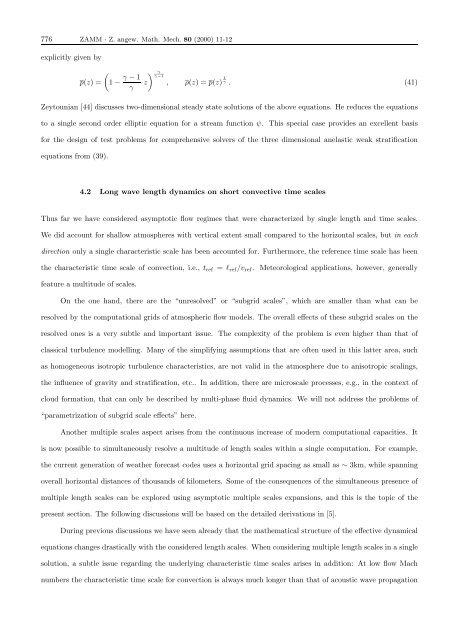Asymptotic Analyses for Atmospheric Flows and ... - FU Berlin, FB MI
Asymptotic Analyses for Atmospheric Flows and ... - FU Berlin, FB MI
Asymptotic Analyses for Atmospheric Flows and ... - FU Berlin, FB MI
You also want an ePaper? Increase the reach of your titles
YUMPU automatically turns print PDFs into web optimized ePapers that Google loves.
776 ZAMM · Z. angew. Math. Mech. 80 (2000) 11-12<br />
explicitly given by<br />
p(z) =<br />
(<br />
1 − γ − 1<br />
γ<br />
) γ<br />
z<br />
γ−1<br />
,<br />
1<br />
ρ(z) =p(z)<br />
γ . (41)<br />
Zeytounian [44] discusses two-dimensional steady state solutions of the above equations. He reduces the equations<br />
to a single second order elliptic equation <strong>for</strong> a stream function ψ. This special case provides an excellent basis<br />
<strong>for</strong> the design of test problems <strong>for</strong> comprehensive solvers of the three dimensional anelastic weak stratification<br />
equations from (39).<br />
4.2 Long wave length dynamics on short convective time scales<br />
Thus far we have considered asymptotic flow regimes that were characterized by single length <strong>and</strong> time scales.<br />
We did account <strong>for</strong> shallow atmospheres with vertical extent small compared to the horizontal scales, but in each<br />
direction only a single characteristic scale has been accounted <strong>for</strong>. Furthermore, the reference time scale has been<br />
the characteristic time scale of convection, i.e., t ref<br />
= l ref /v ref . Meteorological applications, however, generally<br />
feature a multitude of scales.<br />
On the one h<strong>and</strong>, there are the “unresolved” or “subgrid scales”, which are smaller than what can be<br />
resolved by the computational grids of atmospheric flow models. The overall effects of these subgrid scales on the<br />
resolved ones is a very subtle <strong>and</strong> important issue. The complexity of the problem is even higher than that of<br />
classical turbulence modelling. Many of the simplifying assumptions that are often used in this latter area, such<br />
as homogeneous isotropic turbulence characteristics, are not valid in the atmosphere due to anisotropic scalings,<br />
the influence of gravity <strong>and</strong> stratification, etc.. In addition, there are microscale processes, e.g., in the context of<br />
cloud <strong>for</strong>mation, that can only be described by multi-phase fluid dynamics. We will not address the problems of<br />
“parametrization of subgrid scale effects” here.<br />
Another multiple scales aspect arises from the continuous increase of modern computational capacities. It<br />
is now possible to simultaneously resolve a multitude of length scales within a single computation. For example,<br />
the current generation of weather <strong>for</strong>ecast codes uses a horizontal grid spacing as small as ∼ 3km, while spanning<br />
overall horizontal distances of thous<strong>and</strong>s of kilometers. Some of the consequences of the simultaneous presence of<br />
multiple length scales can be explored using asymptotic multiple scales expansions, <strong>and</strong> this is the topic of the<br />
present section. The following discussions will be based on the detailed derivations in [5].<br />
During previous discussions we have seen already that the mathematical structure of the effective dynamical<br />
equations changes drastically with the considered length scales. When considering multiple length scales in a single<br />
solution, a subtle issue regarding the underlying characteristic time scales arises in addition: At low flow Mach<br />
numbers the characteristic time scale <strong>for</strong> convection is always much longer than that of acoustic wave propagation









